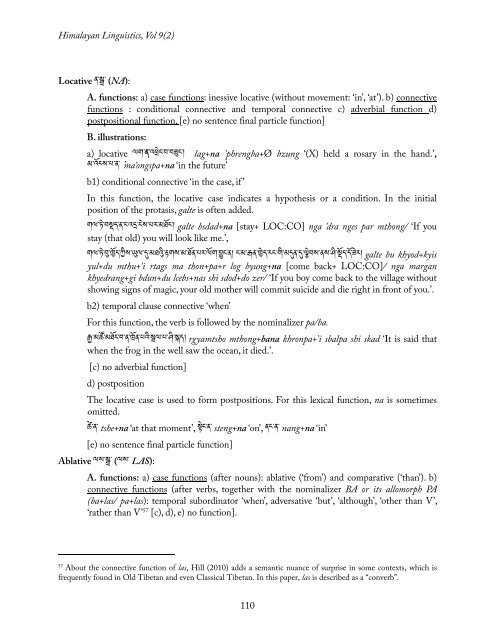The Classical Tibetan cases and their transcategoriality
The Classical Tibetan cases and their transcategoriality
The Classical Tibetan cases and their transcategoriality
You also want an ePaper? Increase the reach of your titles
YUMPU automatically turns print PDFs into web optimized ePapers that Google loves.
Himalayan Linguistics, Vol 9(2)<br />
Locative ན་སྒྲ་ (NA):<br />
A. functions: a) case functions: inessive locative (without movement: ‘in’, ‘at’). b) connective<br />
functions : conditional connective <strong>and</strong> temporal connective c) adverbial function d)<br />
postpositional function, [e) no sentence final particle function]<br />
B. illustrations:<br />
a) locative ལག་ན་འཕྲེང་བ་བཟུང་། lag+na ’phrengba+Ø bzung ‘(X) held a rosary in the h<strong>and</strong>.’,<br />
མ་འོངས་པ་ན་ ་ma’ongspa+na ‘in the future’<br />
b1) conditional connective ‘in the case, if ’<br />
In this function, the locative case indicates a hypothesis or a condition. In the initial<br />
position of the protasis, galte is often added.<br />
གལ་ཏེ་བསྡད་ན་ང་འདྲ་ངེས་པར་མཐོང་། galte bsdad+na [stay+ LOC:CO] nga ’dra nges par mthong/ ‘If you<br />
stay (that old) you will look like me.’,<br />
གལ་ཏེ་བུ་ཁྱོད་ཀྱིས་ཡུལ་དུ་མཐའིུ་རྟགས་མ་ཐོན་པར་ལོག་བྱུང་ན། ང་མ་རྒན་ཁྱེད་རང་གི་མདུན་དུ་ལྕེབས་ནས་ཤི་སྡོད་དོ་ཟེར། galte bu khyod+kyis<br />
yul+du mthu+’i rtags ma thon+pa+r log byung+na [come back+ LOC:CO]/ nga margan<br />
khyedrang+gi bdun+du lcebs+nas shi sdod+do zer/ ‘If you boy come back to the village without<br />
showing signs of magic, your old mother will commit suicide <strong>and</strong> die right in front of you.’.<br />
b2) temporal clause connective ‘when’<br />
For this function, the verb is followed by the nominalizer pa/ba.<br />
རྒྱ་མཚོ་མཐོང་བ་ན་ཁྲོན་པའི་སྦལ་པ་ཤི་སྐད། rgyamtsho mthong+bana khronpa+’i sbalpa shi skad ‘It is said that<br />
when the frog in the well saw the ocean, it died.’.<br />
[c) no adverbial function]<br />
d) postposition<br />
<strong>The</strong> locative case is used to form postpositions. For this lexical function, na is sometimes<br />
omitted.<br />
ཚེ་ན་ tshe+na ‘at that moment’, སྟེང་ན་ steng+na ‘on’, ནང་ན་ nang+na ‘in’<br />
[e) no sentence final particle function]<br />
Ablative ལས་སྒྲ་ (ལས་ LAS):<br />
A. functions: a) case functions (after nouns): ablative (‘from’) <strong>and</strong> comparative (‘than’). b)<br />
connective functions (after verbs, together with the nominalizer BA or its allomorph PA<br />
(ba+las/ pa+las): temporal subordinator ‘when’, adversative ‘but’, ‘although’, ‘other than V’,<br />
‘rather than V’ 57 [c), d), e) no function].<br />
57 About the connective function of las, Hill (2010) adds a semantic nuance of surprise in some contexts, which is<br />
frequently found in Old <strong>Tibetan</strong> <strong>and</strong> even <strong>Classical</strong> <strong>Tibetan</strong>. In this paper, las is described as a “converb”.<br />
110
















